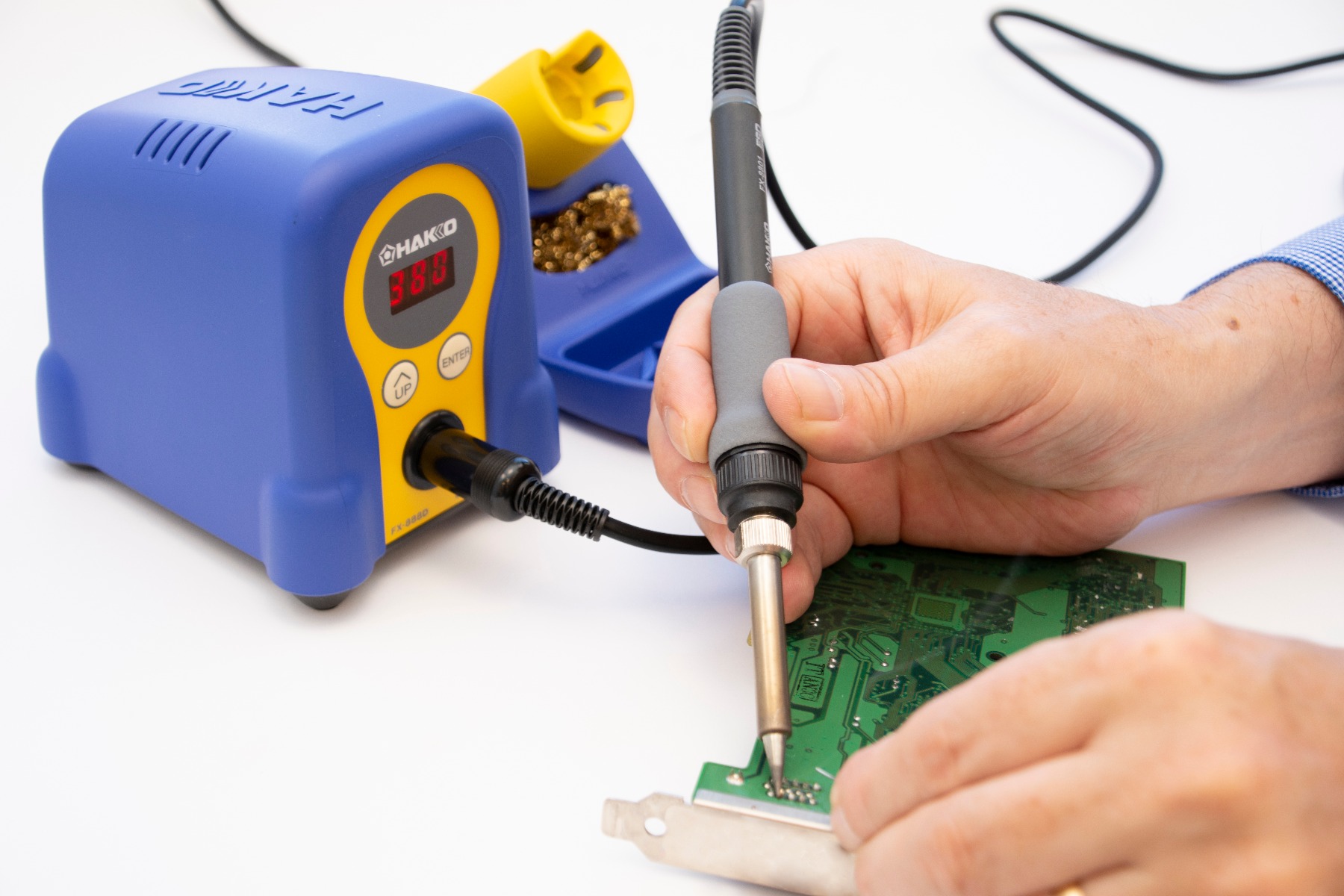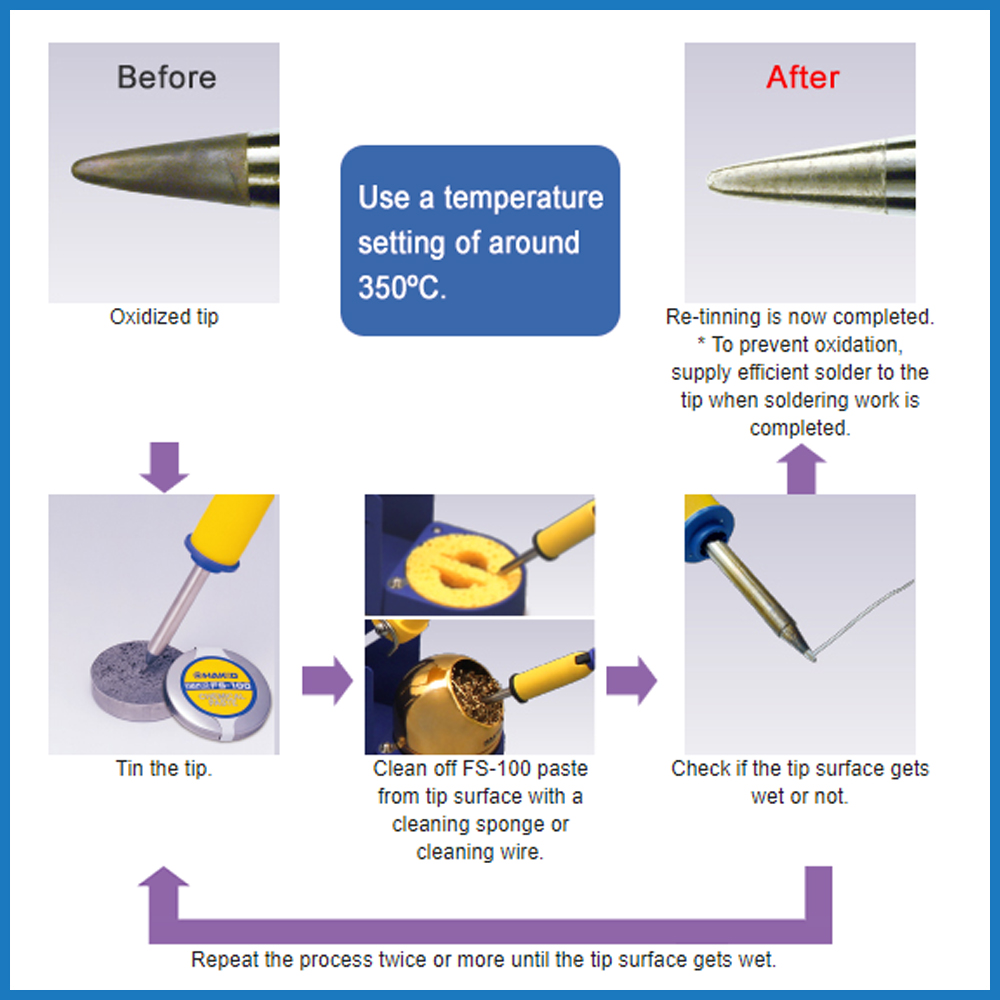No products in the basket.
Dereks Tech Tips – Issue 5

How To Achieve Top Performance From Your HAKKO Tips and Equipment

In this edition of Hakko Tech Tips, we will examine some of the commonly asked questions about Hakko tips and equipment that are fielded by Hakko’s Technical Support team. We will also highlight key points that will help you achieve the best outcome for your soldering process, including better performance, reduced costs and improved work-in-progress.
Why do Soldering Tips and De-Soldering Nozzles oxidize with Lead Free solders?
Lead-free solder oxidises the tip of a soldering iron up to five times faster than if a eutectic solder were used. The EU’s Restriction of Hazardous Substances (RoHS) directive became mandated in 2006, which restricted the use of six hazardous materials in the manufacture of electrical and electronic equipment, including lead – previously an everyday component of solder. Since lead became restricted there has been a wholesale shift from the commonly used tin-lead solder alloys to lead-free alternatives such as those containing mostly tin with small amounts of silver and copper. But whereas eutectic solder has a melting point of 183°C, the most commonly used lead-free solders have melting points in the region of 220°C – and this is at the root of our oxidation problem.
So why do the tips of soldering irons oxidize so easily when using lead-free solder and how can it at least be minimised – at best, avoided altogether? As noted, the melting point of lead-free solder is around 30°C higher than that of a conventional eutectic and this temperature difference, in combination with the non-presence of oxidation-inhibiting lead, is sufficient to accelerate the rate of oxidation of the soldering iron tip by as much as five times when a lead-free solder is used. Determining the pre-set temperature with little regard for the characteristics of lead-free solder and leaving the tip at the high temperature of lead-free solder’s melting point, speeds up oxidization of the tips. If not checked, the inevitable result of this is reduced life expectancy for the soldering iron tip. Having an understanding of the unique characteristics of lead-free solder and maintaining soldering irons in a clean condition will provide the easiest route to preventing soldering iron tips from oxidizing and prematurely ageing.
Why would I use tip cleaning over a conventional sponge – what are the benefits?
Whilst the traditional cleaning sponge is more efficient at removing molten solder from the soldering tip, the Hakko 599B cleaning wire greatly contributes to better removal of the black oxide seen predominantly when using lead-free solders. Furthermore, because the cleaning wire will also leave a small amount of solder on the soldering tip, it also helps to provide less exposure to atmosphere and reduces the level of oxidation. There is also no cause for concern regarding any potential damage that might be caused by using the cleaning wires as they are made entirely from brass. The soldering tip is plated with iron and because this is harder than brass, cleaning with these wires does not scratch or cause any damage to soldering tips. If you want to remove solder thoroughly from the soldering tip regardless, use a sponge type cleaner to clean the tip with a water-moistened sponge.
How do I ensure the best performance from my Hakko equipment?
Hakko equipment over the years has proven to be extremely reliable. Nonetheless, if you want to fully optimise peak performance of your equipment, there are few common-sense guidelines that should be followed:
- Always maintain solder tips. The key to reducing incidences of oxidation is to keep the pre-set temperature of the soldering iron as low as possible to enable sufficient melting of the solder and the production of a satisfactory soldered joint. It is also important to avoid increasing the tip temperature to more than is actually needed.
- Turn off the power at the switch when changing solder tips. Failure to do this can cause electrical arcing in the handset, which may compromise the life of the electrical contacts inside.
- Unless using the soldering iron in a continuous work flow process, it is also advisable to switch the power off between applications to reduce the rate of oxidation.
- Make a habit of covering the tip with new solder before placing the soldering iron into its holder during soldering work and ensure that the tip is covered with new solder at the end of a soldering job.
- For De-Soldering units, ensure that the filters are changed on a regular basis. It is more cost effective to replace a low cost filter or filter pipe than a vacuum pump!
- Keep soldering tips clean. Hakko provide a number of cleaning aids to help prevent and remove oxidation from soldering iron tips.
Sustaining a daily maintenance regime in a clean, dry and well ventilated area will ensure that your Hakko equipment stays in tip top condition. For Soldering Stations, a periodic check of leak voltage, tip-to-ground resistance and tip temperature are advised. The reason for this is that even if the insulation resistance is measured, it will not show the safety at the device side directly because the inside is insulated with a transformer. To prevent device damage and soldering failure, periodically perform these inspections either daily or weekly. Hakko’s Soldering Iron Tester, FG-101, can measure leak voltage, tip-to-ground resistance and the tip temperature (insulation resistance cannot be measured).

Do Hakko stations require calibration – if so, how often?
It is good practice for all soldering tips to be calibrated, especially when using lead-free solders. Despite any technology to the contrary, the build-up of black oxide can insulate the heat from the soldering tip to the component/PCB. As a result, daily use of a digital thermometer such as Hakko’s FG100B is advisable. The process is also recommended when a soldering tip is changed. Hakko’s FG100B Digital Thermometer provides accurate automatic measurement of soldering iron tip temperatures and includes a new AUTO HOLD feature. With this function, the measurement will end automatically once the tip temperature is stabilized, which minimizes individual differences in measuring temperature. When not in use for three minutes, the auto shut-off feature turns the thermometer off to preserve battery life. The design of the thermometer allows for easy measurements from right or left handed operators and the temperature display allows the reading to display in either °C or °F.
Additionally, the FG100B features a low battery alarm as well as a burnout alarm, which signifies a sensor burnout. The product’s design allows for easy access to sensors for quick and easy sensor replacement. There is also an optional temperature probe to measure solder pot temperatures
Is it possible to restore Hakko soldering tips/desoldering nozzles?
This is a question we get asked a lot, and the simple answer is yes. The Hakko FT-700 and FT-710 tip polishers provide a fast and easy way to renew your soldering tips by keeping them clean and free from oxidation, they are also highly effective for lead-free solder. Both tip polishers remove tip oxides, debris, and excess solder without damaging the tip plating, and can be used in conjunction with Hakko’s FS100 Tip Cleaner, a lead-free chemical paste. So, what are the differences between the two tip polishers? The FT-700 consists of two spinning polishing brushes and the FT-710 has counter-rotating brushes that are activated when the tip is pressed into the receptacle chamber.
To restore new life to your soldering iron tips, simply dip the soldering tip into the FS-100 paste to re-tin the tip, then insert the tip between the spinning brushes of the FT-700 or into the counter-rotating brushes of the FT-710 to remove all melted paste. Finally, tin the tip with the solder currently being used, before placing the iron into the holder.
This quick and easy process is simple to adopt into your soldering routine to enjoy the benefits of a clean, oxidation-free tip, especially when working with lead-free alloys.

How do I determine the most suitable tip for my application?
There are a number of factors to take into consideration when selecting the most appropriate tip for your application and equipment. For instance, the type of soldering to be done, the HAKKO soldering station and tip series that you are using, as well as the tip shape and size, are all questions to base your selection on. Selecting the most accurate size of tip will significantly improve soldering performance and reduce costs. There are numerous benefits to getting the right-sized tip. Firstly, heat will be more efficiently transferred to the workpiece, which offers easy wetting by the solder. When wetting by solder is easy, the setting temperature can be set to the lowest possible temperature, which in turn prevents tip oxidation and potential damage to your product. This will consequently prolong the service life of the tip and keep manufacturing costs down in the long-term.
One of the most important things to bear in mind for effective tip selection, is that even though two tips may be similar in size, one may have a greater heat storage capacity, which will greatly contribute to improving the soldering process. Therefore, select a tip with the highest heat storage capacity possible as long as the size is the same (or similar) and still correct for the application. The difference in heat storage can be confirmed by the reduction in temperature for the comparative tips on the same application. If the temperature drop is small, the set temperature can be kept lower. It is unnecessary to set the temperature excessively high. This will reduce tip oxidation, tip replacement costs and, ultimately, the working time required to produce your solder joints thus increasing productivity.
We welcome feedback from our customers and potential new customers, so please do talk to one of our team if you have any questions. Look out for next month’s Hakko Tech Tips where we will be providing more advice on how to get the best performance from your Hakko equipment.

